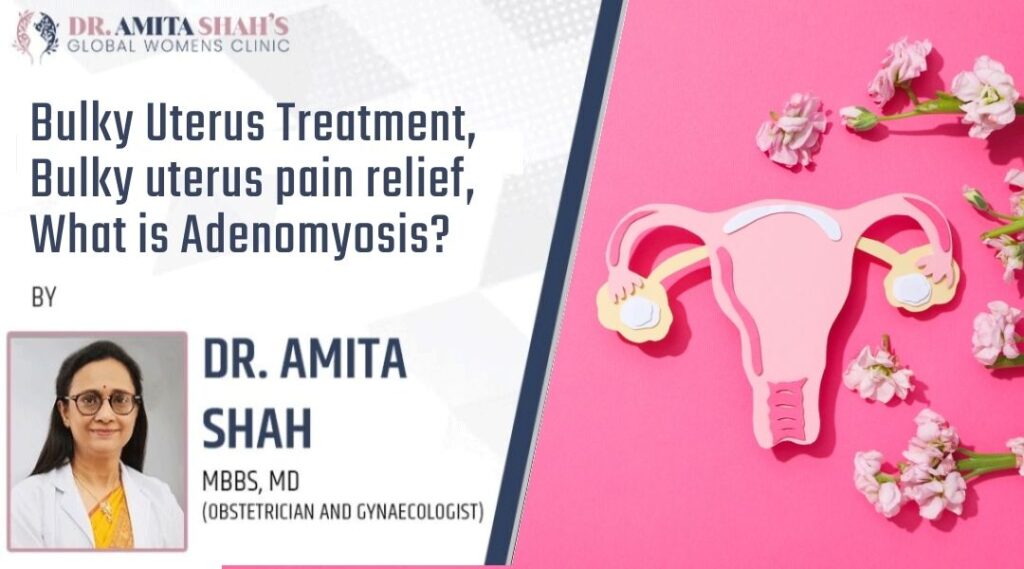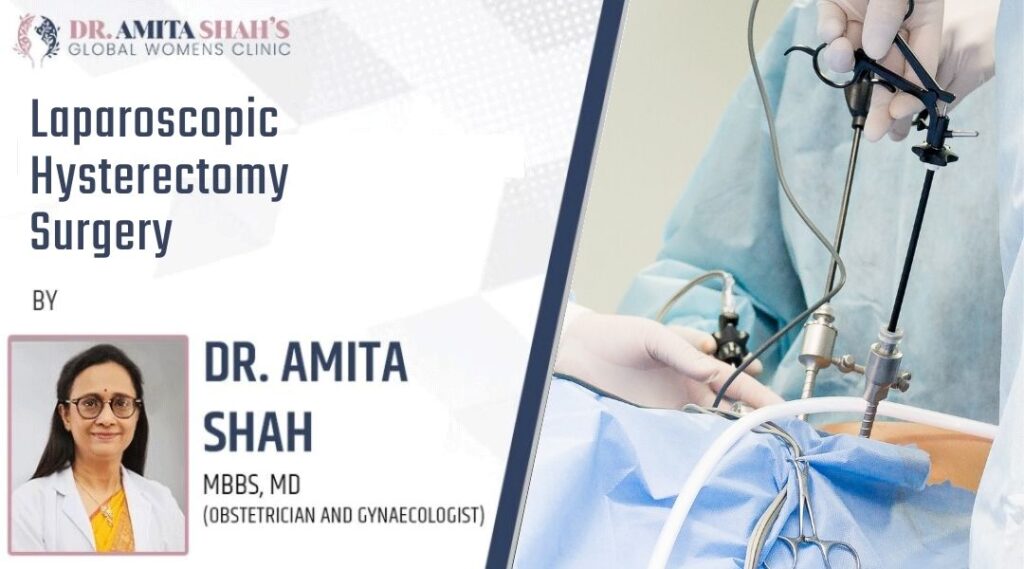Hello and good evening, everybody.
I’m Doctor Amita Shah. I bring greetings from the Global Women’s Clinic, Palam Vihar, Gurgaon. So, today, we are going to talk about fibroids.
What are fibroids, why do they happen, and what are the fibroid treatments?
Is there anything that we can do to prevent these fibroids?
I will talk about fibroids today, and if you have any questions, please use the comment section, and I’ll be happy to answer them.
So, what are fibroids?
Patients generally visit me and complain about Rasoli. Fibroid is known as Rasoli in Hindi.
Fibroids are like tumours, but you must understand that a tumour doesn’t mean cancer. A tumour is not the same as cancer. Fibroids are muscular growths in the uterus.
The uterus means the womb.
So, fibroids are muscular growths that arise from the uterus. So, the uterus is responsible for pregnancy and is responsible for our periods.
The uterus is made up of muscles. There is an outer layer of the uterus. The uterus is muscular and has an outer layer where fibroids can develop.
This inner muscular layer of the uterus can lead to fibroids, which can develop anywhere inside the uterus layer. Fibroid develops in the muscular region of the uterus.
There’s an outer layer of the uterus. If this is the uterus, then this is the outer layer of the uterus this is the muscular layer of the uterus, and this is the inner layer of the uterus. So, the outer layer of the uterus can have fibroids, the inner layer of the uterus can lead to fibroids or the inner layer of the uterus may have fibroids. So, fibroids grow in the muscular region of the uterus.
Often, patients are confused about whether they have a cyst or fibroids.
Any growth that develops on the ovary is known as a cyst or ovarian cyst. So a cyst is like a balloon that accumulates fluid and cysts grow from the ovary.
But fibroids grow from the uterus.
There are three layers in the uterus: the outer, middle, and inner layers. Fibroids can develop anywhere.
If the fibroid develops in the outer layer and grows outward, it is known as a subserosal fibroid.
If the fibroid arises from the muscular region, then this fibroid is known as the fibroid uterus intramural. This fibroid can either grow outward, leading to the subserous fibroid, or it can start entering the uterine cavity, and we call this condition submucosal fibroid.
It refers to a condition when a fibroid starts growing inside and towards the uterine cavity. This type of fibroid is known as a submucosal fibroid.
There are three types of fibroids: subserosal fibroid, fibroid uterus intramural, and submucosal fibroid. So, there are three fibroid types.
Now the question arises as to how and when you will know that you are having fibroid, or what are the symptoms that confirm a fibroid condition? You won’t run ultrasound tests every year. Until you have a problem, you won’t go for an ultrasound test.
So, what are the symptoms of fibroids, or what are the symptoms that will confirm that you are having fibroids?
The symptoms you can have:
Menstrual irregularities, meaning that you may have heavy periods, irregular periods, or spotting during periods.
You may have painful periods, or pains during periods.
You may pass large clots, or you may feel that your lower abdomen or belly is bulging. You may feel like you are growing, but you may not be gaining weight; rather, it may be the size of the fibroid inside your uterus that is enlarging, leading to a bulging abdomen.
If the fibroid has grown large, causing your abdomen to bulge, then you will have problems with urination. This means that you will have a frequency in urination, and you will have the urge to urinate most of the time because the fibroid will exert pressure over the urinary bladder. If this is the uterus and here is the urinary bladder, then the fibroid will exert pressure over the urinary bladder, causing urination symptoms like frequency of urination, and urgency of urination. Sometimes the size of the fibroids is so large that it affects the intestine that lies behind the uterus, causing compression that leads to constipation, or you may have irritable bowel syndrome.
Fibroid may also cause infertility. Like I told you, if your fibroid is growing within the uterus cavity, the place where pregnancy takes place and the baby’s growth happens. Now, you can imagine, that if the fibroid grows inside the cavity, it will interfere with pregnancy. If you conceive, then there are chances of recurrent abortions or may have pre-term delivery.
Even if you complete the term, the fibroid may hinder the baby’s growth due to an inadequate supply of blood as the blood vessels that supply blood to fibroids also supply blood to the baby, hence hindering the baby’s growth.
You may also end up in a pre-term delivery. So, these are the complications you may face due to fibroids.
If you have all these symptoms, then it is easy to diagnose fibroids. So, when you go to the doctor with these symptoms, the first thing the doctor would advise will be an ultrasound test. Now, the fibroids can be easily detected through ultrasound. The ultrasound report exactly confirms the location of the fibroid whether it’s on the outer layer of the uterus, inside the uterus, or it’s in the wall of the uterus. The report also tells about the size of the fibroid.
So, ultrasound is one of the diagnostic criteria that tells you about the number of fibroids and helps to map the fibroid in the uterus.
So, ultrasound is a very simple test and one of the diagnostic tests confirming the presence of fibroid condition and the location of the fibroid.
So, once you are diagnosed with fibroids, the question arises, “Do you need to get treatment for the fibroid or when is the exact time when you need the fibroid uterus treatment, or does every fibroid need to be operated on or needs medical treatment?”
These are all the questions that need to be answered.
Now, all fibroids need not be treated and this is the most important thing that you need to understand.
It is not important to treat all fibroids or undergo fibroid uterus surgery.
So, when do you need to treat fibroid?
Most of the time, fibroids are asymptomatic. Asymptomatic means, exhibiting no symptoms, meaning to say, that the fibroids are simply lying inside the uterus.
If the fibroids are small in size, maybe around 2-3 cm and exhibiting no symptoms like menstrual irregularities, or you are facing no problem in conceiving, then there’s nothing that needs to be done.
The only thing I would suggest is to run an ultrasound test once a year to keep a check on the size of the fibroid. That is all you need to do. Suppose, you come to know that the size of the fibroid hasn’t increased after running an ultrasound test and is not giving you any symptoms, then there’s nothing that needs to be done.
So, when is it that you need a fibroid uterus treatment?
The treatment of fibroid is needed if:
The fibroid is leading to the problem in conception – you are not able to conceive due to fibroid condition, or you are having abortions due to fibroid. In this case, you need to get treatment from the doctor.
Your fibroid is exhibiting symptoms like – you are having heavy periods, causing your haemoglobin level to drop, and clotting.
You are having pain due to fibroids and the pain is so severe that you are been injected for relief.
The fibroids are growing in size and it’s rapidly growing to that extent, appearing like 2-4 months of pregnancy.
These are the conditions when you need to take fibroid uterus treatment.
Now, the question arises, why do fibroids develop?
Often, patients come to me with their ultrasound report, confirming fibroids, and ask why they contracted fibroid condition. This a logical question that ought to pop up in anyone’s mind.
Why did they develop fibroid?
There are no logical or scientific explanations or answers as to why fibroids develop.
I always tell my friend that fibroids are just like skin warts and there’s no specific reason as to why they develop, and the same is true for fibroid development.
Some people are more predisposed to develop fibroids. So, who are those people?
People, who have early puberty – periods started early, or those who have had late menopause, or those not having children. Africans and Americans are more genetically prone to develop fibroids.
Fibroids can happen in any age group but are generally seen in the reproductive groups between 30 to 40 years. But it is not necessary that fibroids may develop between this age group, it may happen even at fifty or sixty years. Fibroids can develop at any time but generally happen between 40 to 50 years.
When is it that you need a fibroid uterus treatment?
You need treatment for your fibroids, if:
Your fibroids are too large or are symptomatic. So this is the right time when you need to go for fibroid treatment.
Now, the questions arise – what is the treatment for fibroids?
Is there a medical treatment available for fibroid or do you always have to go in for fibroid uterus surgery?
Neither homoeopathy nor Ayurveda works in fibroid conditions. There is no homoeopathy nor Ayurvedic medicine for fibroids.
There are certain treatments for fibroids but they come with their side effects, and you have to consult a gynaecologist to check as to what is the right medicine you can take because the doctor can monitor the side effects of the medicine, and give you the right dosage.
However, fibroid uterus surgery is recommended in more than 80% of the fibroid cases.
Now, what kind of surgery is recommended for the fibroids?
Do you know when to go in for only the fibroid removal or for uterus removal?
Are there any other methods that are non-surgical to remove the fibroid?
I will discuss all this in my next session, so stay tuned in and wait for my next session. I will be talking about the various fibroid uterus treatment modalities we have to treat fibroids.
Thank You.
































